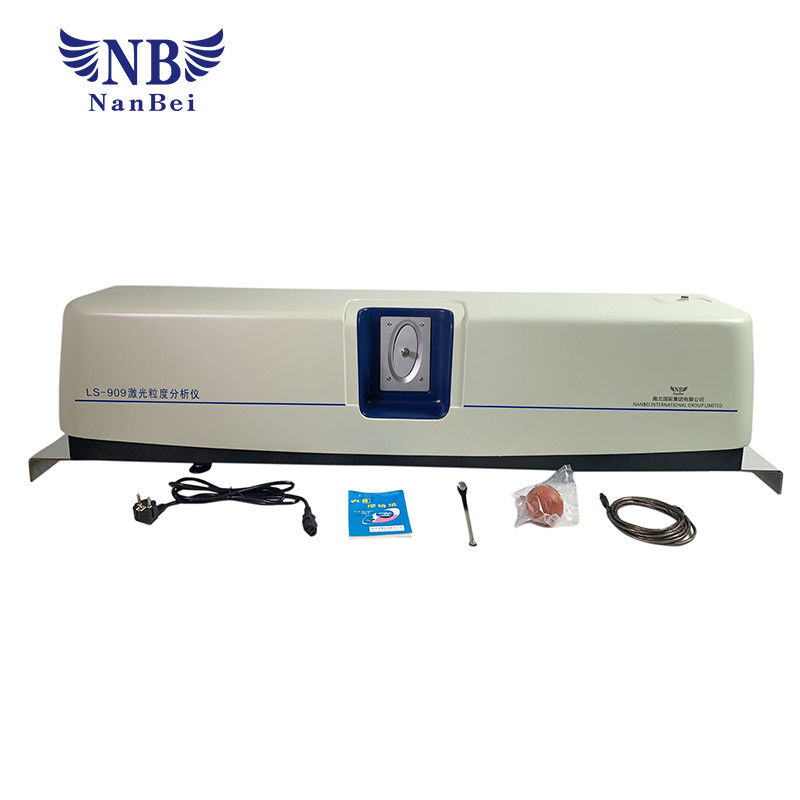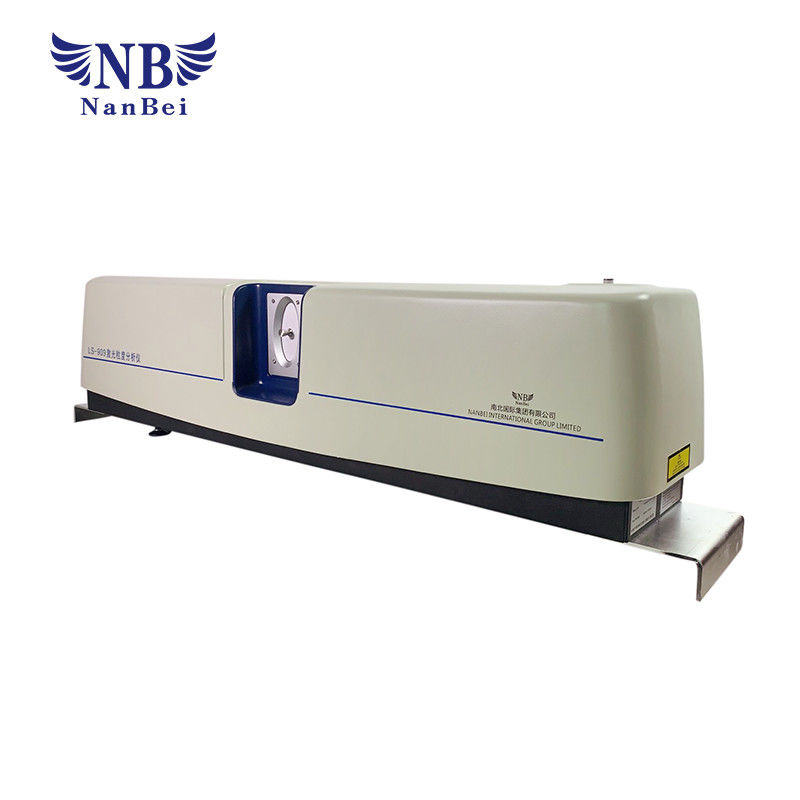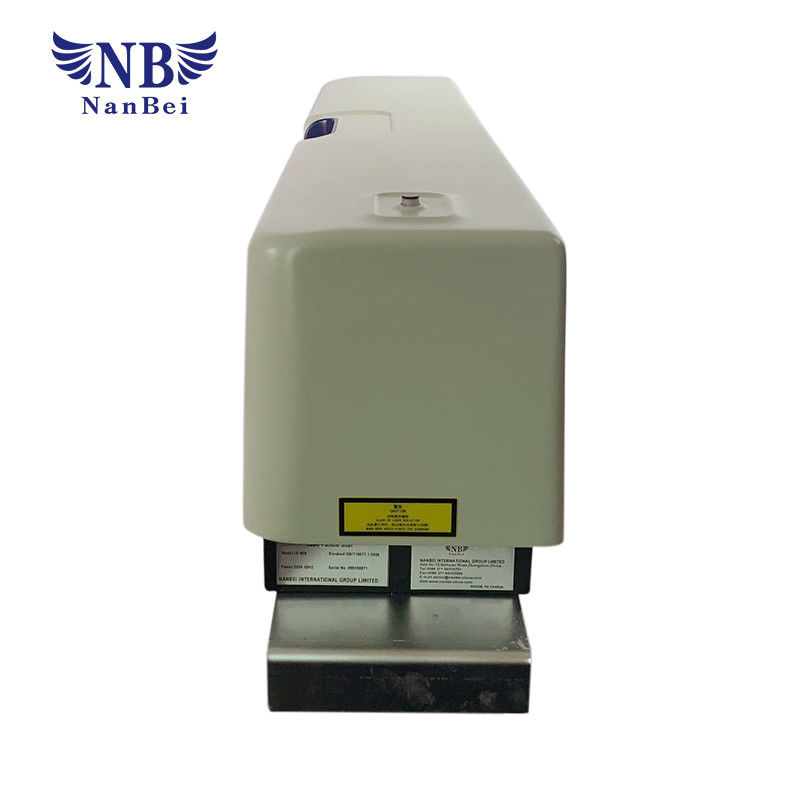High Repeatability Mie scattering laser particle size analyzer
LS-909 is an excellent dry & wet laser particle size analyzer based on customers’ demands for high-performance instrument. LS-909 adopts international advanced long-focus optical detection system, optimized double backward & reverse scattered light detector array, upgraded ADC signal acquisition system and innovative self-adaption noise suppression algorithm combined with imported high-quality He-Ne laser emitter, which can satisfy the demands for wider-distribution particles’ measurement with high automation degree, large dynamic range, good reproducibility and resolving power. This instrument owns intelligent measurement & control analysis software, specialized user-defined measurement report templates, as well as easy operation of report browsing, report contrast and data export.
We are Malvern Brothers company, relying on technical support and advanced management experience, our test results are more closer to Malvern`s test result than other instruments. The instrument uses the same imported laser tube as Malvern. Wet sampling motors are imported from Switzerland. With the bottom ultrasonic technology, the ultrasonic effect is much better than the probe ultrasonic.
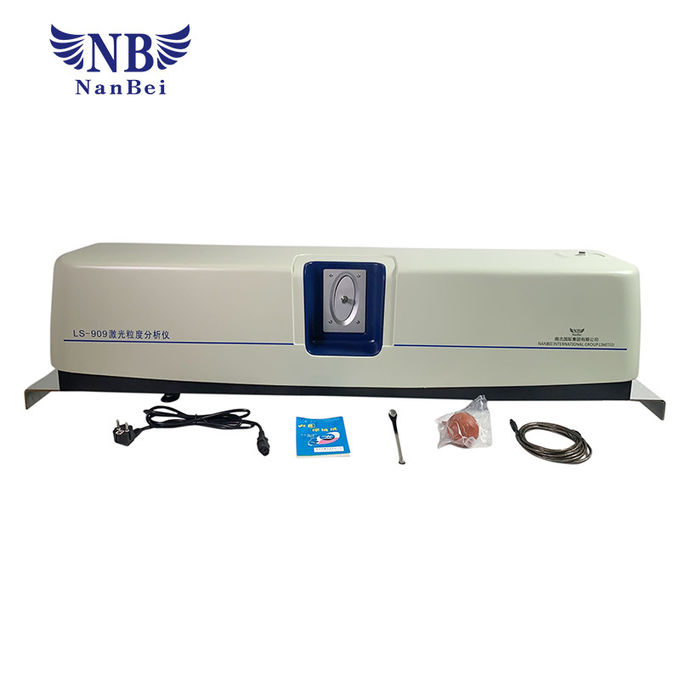
Main engine, dry & wet sample feeding system of LS-909
Applications: Measure the particle size distribution of samples have to be dispersed in liquid or of powders to be dispersed in gas.
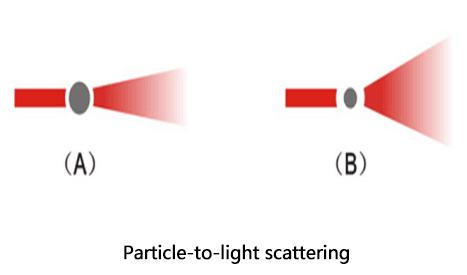
Theory: Light is an electromagnetic wave. When light meets with particles on it way of traveling, the interaction between light and particles will result in deviations of part of the light, which is called light scattering. The bigger the scattering angle is, the particle size will be smaller, the smaller the scattering angle is, the particle size will be bigger. The particle analyzer instruments will analyze the particle distribution according to this physical character of the light wave.
Specifications:
1. Theory: Mie scattering
2. Measuring Range: 0.02~2100μm(wet), 0.1~2100μm (dry)
3. Sample Feeding: wet/dry dispersion(automated circulating)
4. Repeatability: <1% (standard sample D50)
5. Alignment: intelligent automated alignment, accuracy: 0.2μm
6. Measurement Duration: 1-2 minutes
7. Detecting Channels: 91
8. Light Source: imported He-Ne laser, > 2.0 mW, wavelength: 0.6328 μm
9. Analog digital conversion (ADC): 18bit
10. Environmental Requirement:
Temperature: 5-35℃ Humidity:<85%
11. Report Items: Particle size distribution table & graph, Average diameter, Median diameter, SSA, etc.
12. Power supply: 200~240V AC 50Hz 80VA
13. Dimension(L X W X H):1320×340×360mm(mainframe)
1600×450×480mm (packaging)
Technical features
1. Reliable optical platform
LS-909 adopts all-in-one housing design, aluminium alloy base and modular construction design, it’s dust-protected, water-proof and it can prevent stray light from the outside. Debugging tool is used for the mutual alignment of the auxiliary detectors and main detector, which can help to obtain more accurate optical energy data of large angle, the performance of instrument for testing small particles will be improved.
2. Optimized single-lens optical path structure
Light path adopts lens back Fourier transform structure, which breaks through the restriction of Fourier lens’ pupil, the scattered light from all angles even backscattered can be positioned and be received by detectors; and the refracting surface and reflecting surface in the optical path of single lens are minimized, which can further reduce the background noise to the lowest level when the instrument works, the signal to Noise Ratio in the measurement will be improved.

Optical path schematic diagram
3. High-performance imported He-Ne laser emitter
Optical source adopts imported He-Ne laser emitter which owns better monochromaticity, high coherence, small divergence angle and good stability compared to other laser emitters, the optical quality is better, the device owns long service time as the preheating time is short.
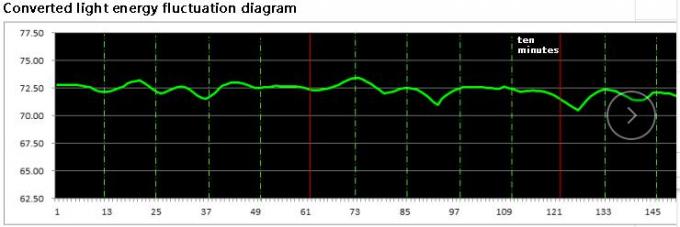
OMEC imported He-Ne laser tube

General laser tube
4. New design of spatial filter & the patent of integrated laser emitter
We also adopt the patent design of integrated laser emitter (patent no.: 00228952.0) and new design of imported permanent magnet spatial filter which eliminates the effects from diffraction ring, combined with the stability test of laser output power and filtering smoothing technique which can get more accurate scattering light energy data, it can further improve the testing performance especially for large particles.
5. High-sensitivity photoelectric detecting array
LS-909 optimizes the photoelectric detecting array, the forward, side, large-angle, double backward and reverse detectors are included. All detectors are accurately placed on the focusing plane of Fourier, combined with large-angle, double backward and reverse detectors, which can realize perfect dynamic range, excellent resolving ability and sensitivity, accurate acquisition of optical energy information for small particles, the lower limit of measurement can reach 0.02μm.
6. Long-focus Fourier lens
LS-909 adopts 556mm long-focus Fourier lens, which makes the measurement window farther away from the plane of photoelectric detecting array, consequently, the scattering light signals of smaller scattered angles have enough space to be detected accurately, the recognition capability of the smallest scattering angle is 0.016°, the measuring capability for large particles can be enhanced, the upper limit can reach 2100μm.
7. Intelligent automated alignment
Intelligent software controls the automated alignment system, which ensures the accurate repeatability for repeated measurement. The accuracy can reach 0.5um, intelligent judgement for alignment function can avoid the deviation of measurement result compared with traditional measurement, the life of alignment mechanism can be longer.
8. Advanced data collection and processing technology
Using 8-channel simultaneous sampling to sample 18 bit ADC and sample & hold switch with ultralow leakage current, the full scale accuracy can reach 0.15%, the electric background is lower, combined with the offset function of electric background, it can help to get more accurate optical energy data, the resolving ability is also enhanced.
9. High-performance, easy-to-use dry-dispersion measurement system
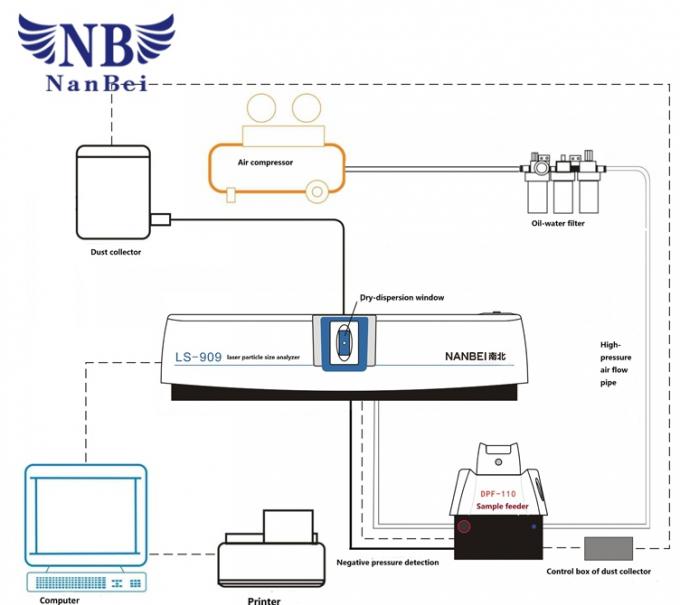
LS-909 dry-dispersion sample feeding system consists of dry sample feeder, totally-enclosed sampling window, mute pump air compressor, oil-water filter, dust collector and other parts. The sampling speed of sample cell is precise and stable, well control of beam obscuration, few consumption of samples. Built-in dispersion pressure sensor can monitor dispersion pressure real-timely and can alert error. This window uses sealed pipeline design, combined with negative pressure protection design of window and high-power dust collector with dust recovery unit to recycle the samples to the maximum so as to protect the machine from being polluted by dust. The above guarantee good reproducibility and authenticity of measurement results for those dry-dispersion samples.
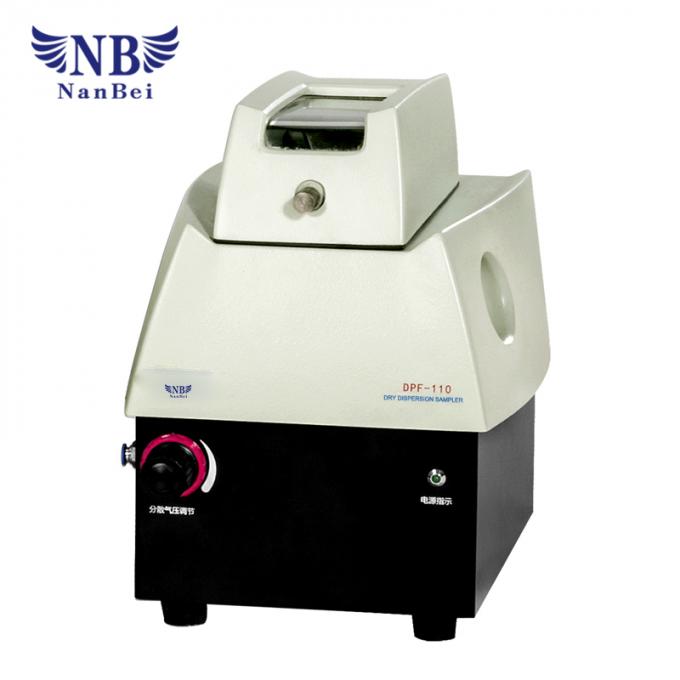
DPF-110 Automated dry-dispersion sample feeding system
1. Concise and fluent design, elegant appearance.
2. Communication recognition between sample feeder and main engine; SOP automated measurement function: automated positive and negative pressure switch, automated feeding, automated sample measuring, automated cleaning.
3. Dispersive pressure 0.5~6Bar, high-precision stepless control, built-in dispersive pressure sensor.
4. Automated recognition of dispersion state of samples, automated restriction of beam obscuration, warning anomaly.
5. Optimized design of sample cell, vibrational frequency is controlled by software, continuously adjustable.
6. Totally-enclosed sample feeder with noise reduction, protect instrument from being polluted by powders, few maintenance demands.
7. Maximum volume of hopper:30ml; sampling vibration acceleration: 0~12G stepless control.
8. Dispersion pipe of sample feeder uses corundum ceramic materials; advantages: good dispersion effects, long life.
9. Specialized dry-dispersion window, quartz glass material, airflow protection, easy to clean, long service life.
10. Modular design, convenient for overhauling and maintenance.
10. High-performance wet-dispersion circulating sample feeding system

SCF-105B Circulating Sample Feeding System
10.1 Technical features of SCF-105B
1. Concise and fluent design, elegant appearance.
2. Self-priming pump owns automatic water feeding, drainage and cleaning functions.
3. Realize the communication with the instrument mainframe, all control and actions are executed by software.
4. The system adopts centrifugal pump structure, high cycle efficiency, high capacity and rapid flow rate.
5. Brushless DC motor (imported from Switzerland), adopts round belt drive, can efficiently reduce the vibration and noise.
6. Sample cell adopts open design for the convenience of operation.
7. Motor speed: 0~4000r/min, can realize stepless adjustment, control accuracy: ±20 rpm
8. Capacity of sample cell: 500ml, maximum flow of circulation loop: ≥2.5L/min
9. Built-in bottom ultrasonic function, power can reach 50W, ultrasonic power and time can realize stepless control.
10. Modular design, convenient for overhauling and maintenance.
11. Dual port for connecting sample feeders, intelligent quick switchover between dry and wet dispersion measurement
Design of dual-port in instrument can realize the connection of dry and wet sample feeders with instrument simultaneously; software can recognize them automatically and switch between them quickly. Window base of sample feeder configured can protect window from being polluted. Easy-to-switch window design and high-precision fast automated alignment make the switchover between dry and wet measurement simple and effective.
- Friendly & practical software Functions
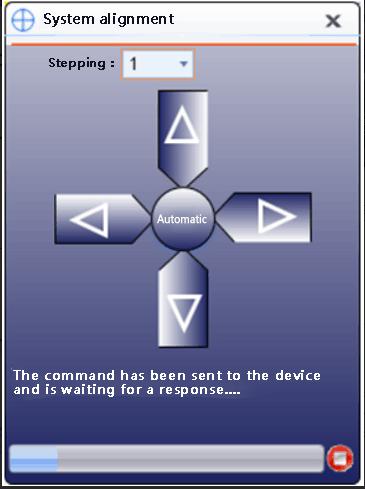
1. SOP standardization operating procedure function, analysis & testing process standardization
2. Options: Automated alignment, manual alignment and one-key automated alignment. The software can realize the self judgement if automated alignment is needed or not.
3. Multiple report models: General purpose, sieving, percentage, average, statistics and fitting reports. The user-defined report template is available. Reports can be exported as PDF, Excel format or other text format files, the reports can be saved by right click.
4. Multiple reports can be viewed at the same time, easy to compare among reports. The reports can be classified/ ranked by date, characteristic particle size, average result or other parameters.
5. Complete, open database of sample material, owns more than 200 kinds of commonly used material parameters. Users can define refractive index parameters by themselves, including real part and imaginary part (correspond to the absorption of sample)
 Your message must be between 3-3,000 characters!
Your message must be between 3-3,000 characters!
 Please check your E-mail!
Please check your E-mail!
 Your message must be between 20-3,000 characters!
Your message must be between 20-3,000 characters!
 Please check your E-mail!
Please check your E-mail!



